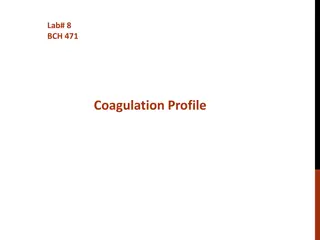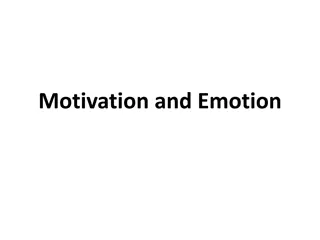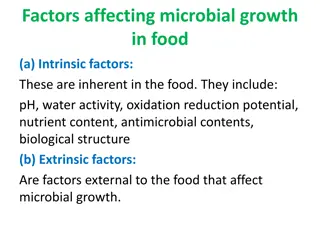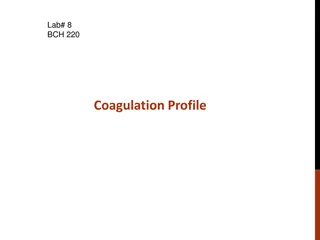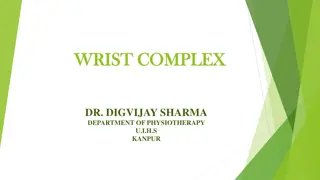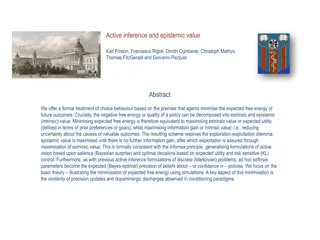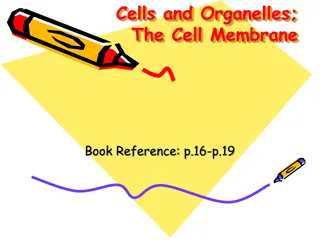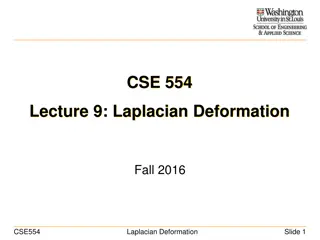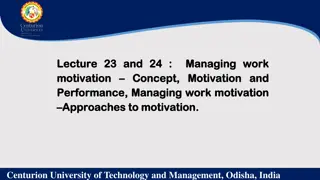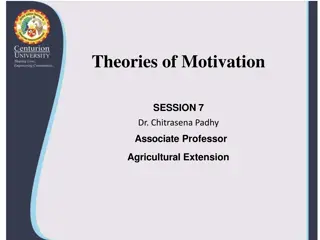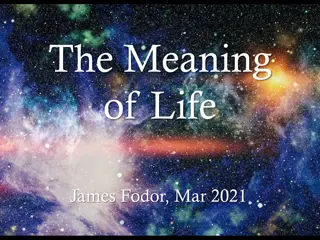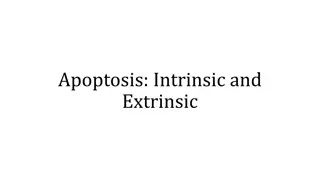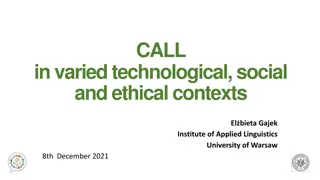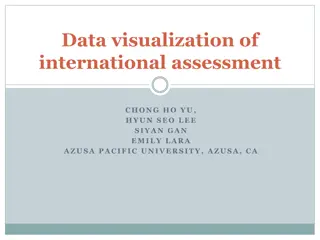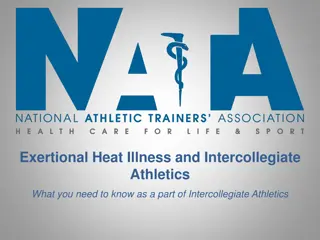Regulation of Glomerular Filtration and GFR Physiology Overview
This detailed study delves into the regulation of glomerular filtration rate (GFR) in the kidneys. It covers the intrinsic and extrinsic mechanisms that control GFR, autoregulation, tubuloglomerular feedback, glomerular filtration membrane, filtration forces, molecular size and filterability of subs
9 views • 20 slides
Coagulation Profile in Hemostasis
Coagulation profile testing is crucial in assessing blood clotting ability. The process of coagulation is essential for hemostasis to prevent bleeding or clotting disorders. This summary explores the steps involved in hemostasis, the clotting cascade, and the triggers for the extrinsic and intrinsic
6 views • 14 slides
Semiconductor and Circuit Manufacturing Market
Semiconductor and Circuit Manufacturing Market by Component (Memory, Logic, Analog, Micro), Semiconductor (Intrinsic, Extrinsic), Material (Silicon, Germanium), Application (Consumer, Automotive, Industrial), & Geography - Global Forecast to 2031.
1 views • 5 slides
Semiconductor and Circuit Manufacturing Market
Semiconductor and Circuit Manufacturing Market by Component (Memory, Logic, Analog, Micro), Semiconductor (Intrinsic, Extrinsic), Material (Silicon, Germanium), Application (Consumer, Automotive, Industrial), & Geography - Global Forecast to 2031.
1 views • 5 slides
Coaching
Coaching involves supporting individuals in making changes and achieving goals. Motivation initiates and maintains goal-oriented behaviors, with intrinsic and extrinsic motivations playing key roles. Assessment is a systematic process of gathering data to understand what learners know. Various appro
2 views • 13 slides
Growing Careers for Positive Change: Aligning Actions with Values
The lesson focuses on helping individuals align their actions with their values, emphasizing the impact of intrinsic and extrinsic values on personal wellbeing and decision-making. Through activities like Diamond 9 Values, students explore the importance of values in career choice and relationships,
1 views • 15 slides
Falls Prevention in Older People: Key Concepts and Strategies
Falls prevention in older people is crucial due to the high prevalence of falls in this age group, leading to injuries, disabilities, and increased healthcare costs. Key concepts include recognizing falls as a significant threat in later life and identifying intrinsic and extrinsic factors contribut
1 views • 33 slides
The Impact of Temperature on Fermi Level in Semiconductors
The Fermi level plays a crucial role in determining the behavior of electrons in semiconductors at different temperatures. As temperature increases, the Fermi level shifts, affecting the generation of free electrons and holes in the valence and conduction bands. In intrinsic semiconductors, electron
3 views • 53 slides
Motivation and Emotion: Key Concepts and Types Explained
Motivation, derived from Latin "movere" meaning to move, is a force that drives behavior towards goals. It encompasses intrinsic and extrinsic motivation, different types of motives such as primary, stimulus, and secondary motives, and the interplay of needs and desires that influence human behavior
4 views • 27 slides
Motivation for Academic Success
Explore the importance of motivation in academic pursuits, as explained by guest speaker Hlumelo Sonjani. Learn about the concepts of intrinsic and extrinsic motivation, the impact of motivation on learning effectiveness, and strategies to stay motivated in challenging situations. Gain insights into
1 views • 10 slides
Factors Affecting Microbial Growth in Food: Intrinsic and Extrinsic Factors
In food, microbial growth is influenced by intrinsic factors like pH, water activity, nutrient content, and extrinsic factors such as environmental conditions. The pH level, moisture content, and water activity play crucial roles in determining the growth of microorganisms, with specific ranges affe
2 views • 23 slides
Coagulation Profile: A Comprehensive Overview
Coagulation is a crucial process in hemostasis that involves clot formation. This profile delves into estimating clotting time, bleeding time, and prothrombin time to assess coagulation status. Explore the mechanisms of hemostasis, clotting cascade, triggers of intrinsic and extrinsic pathways, and
0 views • 12 slides
Motivation and Emotion Theories
The chapter delves into various theories of motivation, including instinct theory, drive-reduction theory, incentive theory, and cognitive theory, explaining how internal states and external stimuli influence behavior. It also explores biological and social motives such as hunger and the roles of di
1 views • 29 slides
Nasmyth's Membrane and Dentigerous Cysts in Dental Health
Nasmyth's Membrane is a residue found on newly erupted teeth, causing extrinsic staining. It can be treated with selective polishing and proper brushing. Dentigerous cysts, odontogenic cysts associated with developing teeth, may lead to dental issues. Treatment for cysts includes monitoring and, if
0 views • 9 slides
The Anatomy of the Wrist Complex
The wrist complex consists of the radiocarpal joint and midcarpal joint, formed by various bones and ligaments. The radiocarpal joint involves the radius, radioulnar disc, scaphoid, lunate, and triquetral bones. In a neutral position, the ulna does not participate in this joint. The midcarpal joint
0 views • 16 slides
Factors Influencing Microbial Growth in Foods
Intrinsic and extrinsic parameters play a crucial role in determining microbial growth in foods. Factors such as pH levels, water activity, and the type of food environment greatly influence the proliferation of microorganisms. Understanding these parameters is essential for food safety and preserva
0 views • 22 slides
Active Inference and Epistemic Value
This study presents a formal framework for decision-making, suggesting that agents minimize expected free energy of future outcomes by balancing extrinsic and epistemic values. By maximizing information gain and reducing uncertainty, agents navigate the exploration-exploitation dilemma. The strategy
0 views • 18 slides
Cell Membrane Structure and Proteins
Exploring the basic structure of membranes, the distribution of proteins within the membrane, intrinsic vs. extrinsic proteins, the fluid mosaic model, phospholipids forming the bilayer, the role of hydrophilic and hydrophobic parts in phospholipids, polysaccharides, and the differences between glyc
0 views • 18 slides
Conductivity and Current in Extrinsic Semiconductors
This content delves into the intricacies of conductivity in extrinsic semiconductors, exploring the behavior of carriers in n-type and p-type materials. It covers topics such as drift current density, diffusion current density, the Einstein relation, recombination, and the Hall effect. Practical exa
0 views • 8 slides
Silicon Detector Technology
Silicon is a remarkable material with low energy requirements for creating e-hole pairs, long mean free paths, high mobility for fast charge collection, and well-developed technology for fine lithography. Silicon detectors operate based on carrier band diagrams, density of states, and Fermi-Dirac di
0 views • 21 slides
Extrinsic Semiconductors: Fermi Level and Doping Effects
Extrinsic semiconductors play a crucial role in modern electronics by allowing controlled addition of impurities to tailor conductivity. The Fermi level in extrinsic semiconductors shifts based on the number of electrons and holes in the conduction and valence bands, influencing conductivity. Doping
0 views • 14 slides
Insights into Semiconductor Behavior and Mobility Influence
Understanding the intrinsic and extrinsic behavior of semiconductors with respect to temperature dependence, carrier concentration, and mobility. Exploring the impact of temperature and doping on carrier mobility through lattice and impurity scattering effects. Examining the invariance of Fermi leve
0 views • 8 slides
Semiconductors: Intrinsic and Extrinsic Types
Semiconductors play a crucial role in electronic devices, with materials falling into three categories based on electric conductivity: Conductors, Insulators, and Semiconductors. Intrinsic semiconductors are chemically pure, while extrinsic semiconductors have impurities added to enhance their condu
0 views • 39 slides
Laplacian Deformation in Engineering and Applied Science
Laplacian deformation is a technique used in non-rigid registration to account for shape variance and improve fitting between source and target shapes. This method involves minimizing the distance and distortion terms to achieve accurate alignment. Intrinsic and extrinsic methods are discussed, wher
0 views • 53 slides
The Principles of Staining in Histopathology
Staining is a crucial technique in histopathology that involves adding specific dyes to biological substrates to visualize and differentiate cell and tissue components. This chapter covers the principles of staining, types of stains used, factors influencing staining affinity, and common stains empl
0 views • 43 slides
Guidelines for Facilitating AI Learning in Grades 7-12
These guidelines focus on facilitating the learning of Artificial Intelligence by school students in Grades 7-12. The approach includes developing real-time feedback mechanisms, progress mechanics to motivate students, and gamification based on the Self-determination Theory. Emphasis is placed on in
0 views • 15 slides
Motivation: Concepts, Theories, and Approaches
Motivation is the driving force behind human actions, encompassing intrinsic and extrinsic factors. This article explores the importance of motivation in achieving goals, improving well-being, and avoiding negative behaviors. It delves into various theories of motivation, including content and proce
0 views • 11 slides
Theories of Motivation in Human Behavior
Motivation is a driving force that influences human behavior, with various theories seeking to explain and understand what motivates individuals. From intrinsic and extrinsic motivations to prominent theories like Maslow's hierarchy of needs and McClelland's learned needs theory, this session delves
0 views • 21 slides
Principles of Interpreting Wills and Contracts According to UKSC Cases
When interpreting contracts or wills, the court aims to discern the intention of the parties by considering the natural meaning of words, document's purpose, known facts, and common sense, while ignoring subjective intentions. The principles outlined in UKSC cases like Marley v Rawlings emphasize in
0 views • 18 slides
Philosophical Perspectives on the Meaning of Life
Delve into discussions on atheism, naturalism, theories of meaning, subjective and objective aspects of experience, theories of value, and the role of God in understanding the purpose and significance of human life. Philosophers like Susan Wolf and Joseph Raz offer insights into how engaging in valu
0 views • 11 slides
Effective Rewards and Recognition Strategies in Human Resource Management
In this workshop, led by Jagath Karunathilaka, participants will delve into the crucial aspects of strengthening human resource management in civil society organizations. The session covers various topics such as business code practices, recruitment processes, rewards and recognition schemes, confli
0 views • 58 slides
Apoptosis: Intrinsic and Extrinsic Pathways
Apoptosis, a programmed cell death process occurring in multicellular organisms, involves characteristic cellular changes leading to cell death. Approximately 50-70 billion cells die daily through apoptosis in humans, serving vital roles like embryo development. Unlike necrosis, apoptosis is a regul
0 views • 18 slides
Crowdsourcing in CALL: Applications and Implications
Explore the diverse applications of crowdsourcing in Computer-Assisted Language Learning (CALL) within technological, social, and ethical contexts. Uncover success stories in areas like administration, business, medicine, and more. Delve into how crowdsourcing impacts education, language learning, a
0 views • 25 slides
Energy Level Formation in Semiconductor Materials
Energy levels in isolated atomic structures form discrete levels which expand to bands in insulators, semiconductors, and conductors. Extrinsic materials like n-type and p-type are created by doping semiconductors with impurity atoms to alter conductivity. The n-type material involves adding pentava
0 views • 4 slides
The Clotting Cascade and Hemostasis
The clotting cascade is a complex process involving intrinsic and extrinsic pathways that converge to form fibrin, leading to clot formation. Hemostasis is initiated mainly through the extrinsic pathway in vivo, activating factors that generate thrombin and ultimately convert fibrinogen into insolub
0 views • 11 slides
Correlation Between Self-Efficacy and Test Performance Based on International Assessment Data
Explore the correlation between self-efficacy, readiness to learn, intrinsic and extrinsic motivation with test performance using data from international assessments like PISA and PIAAC. Learn about the limitations of linear models in psychological research and the debate around self-efficacy accord
0 views • 32 slides
Managing Exertional Heat Illness in Intercollegiate Athletics
This resource provides essential information on exertional heat illness (EHI) in intercollegiate athletics, including intrinsic and extrinsic risk factors, general risk reduction considerations, dehydration management, and heat cramps. Recognizing, treating, and preventing EHI is crucial for athlete
0 views • 10 slides
Coagulation Profile
Vital process in hemostasis, crucial for blood clot formation. Discover the mechanisms behind coagulation, including intrinsic and extrinsic pathways. Learn about clotting cascade, clotting time estimation, and the role of vascular spasm, platelet plug formation, and blood coagulation in maintaining
0 views • 12 slides
Coagulation Mechanisms
A lecture on blood coagulation mechanisms, including clotting factors, intrinsic and extrinsic pathways, fibrinolysis, and anticoagulants. Learn about the physiological balance crucial for hemostasis and understand the formation of a clot through fibrin meshwork. Explore key factors like Prothrombin
0 views • 23 slides
Essential Concepts in Haemostasis and Thrombosis
Haemostasis and thrombosis are crucial processes in maintaining vascular integrity and preventing excessive bleeding or clotting. This module explores the mechanisms of haemostasis, including vasoconstriction, platelet plug formation, and coagulation cascade activation, as well as the pathophysiolog
0 views • 31 slides

